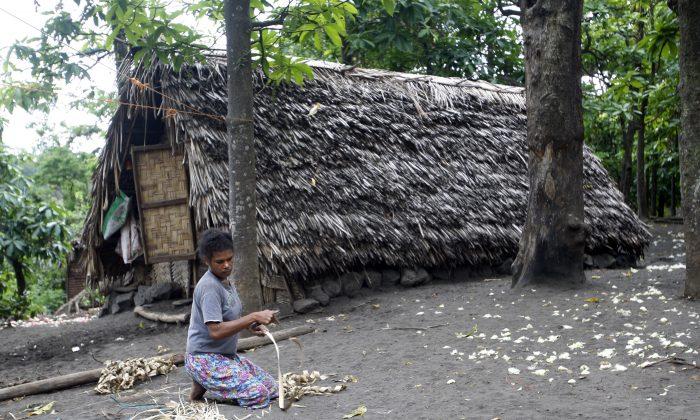TAKARA, Vanuatu— Many people living in this coastal village in Vanuatu believe the March cyclone that sent waves surging through their homes was the latest and most dramatic sign of climate change. They are now considering rebuilding their entire community on higher ground.
Cyclone Pam struck the Pacific archipelago three months ago, blasting the islands with winds of 270 kilometers (168 miles) per hour, killing at least 11 people and affecting 180,000 more by destroying their homes and crops. Many residents saw it as part of broader environmental changes they’ve witnessed in recent years, from higher sea levels to trees bearing fruit out of season.
“We have seen a lot of changes in our weather patterns. The level of the sea rise. And it is affecting the nation at the moment,” said Vanuatu President Baldwin Lonsdale in an interview with The Associated Press. “The impact of climate change is quite real in Vanuatu.”
Parts of Vanuatu are low-lying and are starting to see visible signs of rising sea levels as the earth warms and ice caps melt. The world’s oceans have risen nearly 7 centimeters (nearly 3 inches) since 1992, scientists at the U.S. National Oceanic and Atmospheric Administration say, and are projected to rise at a faster rate in the decades to come.
More damaging than the overall rise, however, are the unpredictable surges brought on by more severe storms. While scientists caution that singular events like the cyclone can’t be attributed solely to climate change, many say there is a link to a general increase in violent weather.
“The short answer would be that certainly there is a connection between climate change and extreme weather,” said Debarati Guha-Sapir, a professor at the University of Louvain School of Public Health in Brussels. “The numbers of storms and high wind events have been increasing. So have droughts, in fact, and all of these are very connected to climate change.”
She said there’s likely to be an increase in catastrophic flooding in coming years and people need to better prepare for that.
Vanuatu isn’t the only Pacific island nation figuring out how to face climate change. Low-lying Kiribati has purchased land in Fiji, which Kiribati President Anote Tong says is an investment and also a guarantee in case the entire nation needs to move.
In Takara, which is on Vanuatu’s main island of Efate, village chief Benjamin Tamata said he wants to move the village of about 200 people inland by about 300 meters (1,000 feet) to move away from the rising seas and to avoid future storm surges.
“When the cyclone came to my village, it’s not only the cyclone,” he said. “With the sea level rising, it came through and damaged our houses. And some of the people run away.”
He said many escaped to a nearby school, but now it’s time to plan for the long term.
“We try to relocate,” he said. “To take all the people from this village and we try to relocate where we can be safe, or where we can survive from the sea.”
If Takara does move inland, it won’t be the first village to do so in Vanuatu. A decade ago, dozens of villagers on Tegua Island moved inland in what the U.N. described as one of the first cases of mass displacement triggered by global warming.
“Staff from the meteorological office and hazard department, they went and assessed the level of sea rise,” said Lonsdale. “And they advised people to move inland. And so they assisted. They assisted the communities and we have moved them further up from the coastal area.”
NOAA, NASA, the Japanese weather agency, and the World Meteorological Organization all declared 2014 the hottest year on record, with NOAA putting 2014 at an average of 58.26 degrees Fahrenheit (14.6 Celsius).
As the world gets warmer, water expands, so the seas rise. But on top of that, ice sheets in Greenland and west Antarctica are melting, as are world glaciers, and scientists worry that meltwater will dramatically increase sea level by about 1 meter by the end of the century.
Islanders are also noticing other effects of climate change, said Shadrack Welegtabit, the director of Vanuatu’s National Disaster Management Office. He said trees are bearing fruit and nuts all year round, instead of in distinct seasons like in the past.
“Not only in Vanuatu, but probably in the Pacific as a whole, climate change does have an impact,” Welegtabit said. “We are beginning to see changes in the weather patterns. We are beginning to have more intense weather, more severe cyclones.”
Vanuatu has made strides in its rebuilding efforts since the cyclone, and many tourism operators are hoping that the tourists who help power the economy will soon return. But for others, like Vila North School Principal Elina Jaywelson Gilu, the rebuild has been painfully slow.
She’s still operating three classes from a tent provided by aid agency UNICEF while she waits for her classroom buildings to get new roofs.
“You can just imagine our classes are very noisy, and it’s really, really hard to get the students to concentrate,” she said. “Because they are all under one roof and it’s not been partitioned to separate the classes. And they are all sitting on the floor.”
Shirley Laban, the climate change adaptation manager in Vanuatu for aid agency Oxfam, said its time for the world to get serious about tackling climate change.
“What more can we show you. Category-5 Cyclone Pam is the real evidence already,” she said. “We need to cut down on this carbon emission. Because as long as we do not cut down, vulnerable individuals, countries, women and children will continue to be impacted.”






Friends Read Free